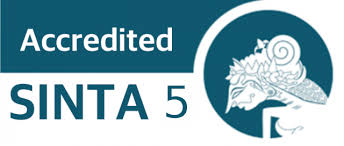Analisis Efisiensi Teknis Produksi Ikan Pari Asap Pada Sentra Ikan Asap Kenjeran Kota Surabaya
Keywords:
Produksi Frontier, Efisiensi Teknis, Ikan Pari AsapAbstract
The aim of this research is to analyze the achievement of the level of technical efficiency and the factors that influence the stingray smoking business at the Kenjeran Smoked Fish Center, Surabaya City. The research method used is the survey method. The data analysis method uses descriptive analysis and frontier production functions. Production inputs are stingrays, ice, water, wrapping leaves, fuel, food coloring, bamboo clamps and labor. The sampling technique used a census technique of 23 people. The average age of smoked stingray producers in Kenjeran is 42 years. In terms of education, the average education level of producers reaches 8 years. Meanwhile, the average experience of producers in the smoked stingray business is 8 years. The gamma value obtained was 0.131 and was not significant. This shows that 13.1 percent of the variation in smoked stingray production in Kenjeran is caused by differences in technical efficiency, while the remaining 86.9 percent is influenced by significant external factors and is outside the producer's control. The results of the partial test (t test) on the production function indicated that the number of fish, clean water, bamboo clamps, wrapping leaves, and labor significantly influenced the production of smoked stingrays in Kenjeran. However, the estimation results show that the age variable does not have a significant influence on the level of business inefficiency. Apart from that, education and experience variables also do not statistically influence the level of inefficiency of smoked stingray producers. Analysis of technical efficiency levels shows that the technical efficiency values achieved by producers range from 0.953 (minimum value) to 0.998 (maximum value), with an average of 0.984. Of the 23 smoked stingray producers analyzed, 13 producers (56.52 percent) had an efficiency level above the average, while 10 other producers (43.48 percent) were below the average level of technical efficiency.
Downloads
References
Asmara, R., Nuhfil H., Niken I. 2011.Analisis Efisiensi Teknis Dengan Pendekatan Frontier Pada Usahatani Chips Mocaf (Modified Cassava Flour). Jurnal Habitat. 22(1): 51-59. Anggranbataini, N.,
Coelli, T. J. 1995. Recent Developments in Frontier Modeling and Efficiency Measure
Heruwati, E. S. (2002). Pengolahan Ikan Secara Tradisional: Prospek dan Peluang Pengembangan. Jurnal Litbang Pertanian, 21(3), 92–99.
Hidayat, Tiara Ramadhani (2020) Analisis Pengaruh Modal Usaha, Teknologi, dan Lama Usaha Terhadap Tingkat Pendapatan Pedagang pada Sentra Ikan Pari Asap Di Kenjeran Surabaya 2020. Bachelor (S1) thesis, Wijaya Kusuma Surabaya University.
Fiqlia, S. C. (2019). Strategi Pengembangan Usaha Ikan Pari Asap pada Sentra Asap Indah. Skripsi. Universitas Semarang, Fakultas Ekonomi.
Martasuganda, S, dkk.2003.Teknologi Untuk PemberdayaanMasyarakat Pesisir. Dirjen Pemberdayaan MasyarakatPesisir. Departemen Kelautan dan Perikanan, Jakarta.
Maryanto. A., Ketut Sukiyono dan Basuki Sigit Priyono. 2018. Analisis Efisiensi Teknis dan Faktor Penentunya Pada Usahatani Kentang (Solanumtuberosum L) di Kota Pagar Alam Provinsi Sumatera Selatan. Jurnal Agraris. 4(1):1-8.
Natalia, D., & Nurozy. (2012). Kinerja Daya Saing Produk Perikanan Indonesia di Pasar Global. Buletin Ilmiah Litbang Perdagangan, 6(1), 69–88.
Nurhayati. 2008. Studi Perbandingan Metode Sampling Antara Simple Random Dengan Stratified Random. Jurnal Basis data, ICT Research Center UNAS. 3(1): 18-32
Rizkiyah, N.,Syafrial dan Nuhfil, H. 2014. Faktor-Faktor Yang Mempengaruhi Efisiensi Teknis Usahatani Kentang (Solonum Tuberosum L) Dengan Pendekatan Stochastic Production Frontier (Kasus Desa Sumber BRantas KEcamatan Bumiaji Kota Batu). Jurnal HABITAT. 25(1): 26-31.
Sukiyono, K and M. Mustopa Romdhon. 2016. Assessing technical efficiency for Bengkulu province catching fishery industries and determination of it’s technical efficiency. International Journal of Fisheries and Aquatic Studies; 4(6): 168-174.
Sukiyono, K. 2004. Analisa Fungsi Produksi dan Efisiensi Teknik: Aplikasi Fungsi Produksi Pada Usahatani Cabai Di Kecamatan Selupu Rejang, Kabupaten Rejang Lebong. Jurnal Ilmu-Ilmu Pertanian Indonesia. 6(2): 104-110.
Sukiyono, K. 2005. Faktor Penentu Tingkat Efisiensi Teknik Usahatani Cabai Merah di Kecamatan Selupu Rejang, Kabupaten Rejang Lebong. Jurnal Agro Ekonomi. 23(2): 176 – 190.
Sulistijowati, R., Djunaedi, O. S., Nurhajati, J., Afrianto, E., & Udin, Z. (2011). Mekanisme Pengasapan Ikan (W. Nadeak, Ed.; 1st ed.). UNPAD PRESS.
Tamrin, S. 2014. Faktor-Faktor Yang Mempengaruhi Produksi Usahatani Kopi Arabika di Kabupaten Enrekang Sulawesi Selatan. Jurnal AGRIC. 26 (1): 1-6
Fadillah, N., Winarno, S.R., Hendrarrini, H. 2021. Analisis Faktor Pemilihan Lokasi Usaha Pedagang Ikan Pari Asap di Sekitar Pantai Kenjeran, Kecamatan Bulak. Jurnal Ilmiah Mahasiswa AGROINFO GALUH, 8(2): 936-954
Downloads
Published
How to Cite
Issue
Section
License
Copyright (c) 2024 Angga Pratama Putra, Regita Faridtunisa Wijayanti, Nurul Hayati, Ani Sulistiawati, Sutrisno Sutrisno, Dinda Winiastri

This work is licensed under a Creative Commons Attribution-ShareAlike 4.0 International License.
Most read articles by the same author(s)
- Angga Pratama Putra, Totok Hendarto, Regita Faridtunisa Wijayanti, Nurul Hayati, Maria Agustini, Muhajir Muhajir, Indra Wirawan, Didik Budiyanto, Mikael Bambang Sigit Sucahyo, Nunuk Hariyani, Ani Sulistiawati, Analisis Partisipasi Masyarakat Pada Kawasan Minapolitan di Kabupaten Trenggalek, Provinsi Jawa Timur , Jurnal Media Informatika: Vol. 6 No. 1 (2024): Jurnal Media Informatika Edisi September - Desember
- Ani Sulistiawati, Sutrisno Sutrisno, Angga Pratama Putra, Totok Hendarto, Nurul Hayati, Muhajir Muhajir, Maria Agustini, Indra Wirawan, Analisis Laju Pertumbuhan Pendapatan Asli Daerah (PAD), Pajak Daerah, Retribusi Daerah, Hasil Perusahaan Milik Daerah dan Pengelolaan Kekayaan Daerah yang Dipisahkan dan Lain-lain PAD Yang Sah di Kabupaten Probolinggo Provinsi Jawa Timur , Jurnal Media Informatika: Vol. 6 No. 3 (2025): Jurnal Media Informatika
- Ningtyas Dwiana Putri, Totok Hendarto, Angga Pratama Putra, Analisis Kelayakan Usaha Abon Ikan Lele pada UMKM Jaya Mandiri Tasikmalaya , Jurnal Media Informatika: Vol. 6 No. 5 (2025): Edisi Sep - Oktober 2025

 Angga Pratama Putra,
Universitas Dr. Soetomo, Surabaya,
Indonesia
Angga Pratama Putra,
Universitas Dr. Soetomo, Surabaya,
Indonesia 









